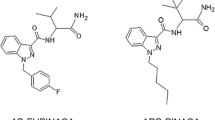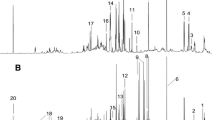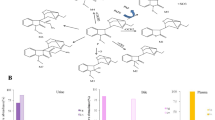Abstract
As an arsenical, realgar (As4S4) is known as a poison and paradoxically as a therapeutic agent. However, a complete understanding of the precise biochemical alterations accompanying the toxicity and therapy effects of realgar is lacking. Using a combined ultrafast liquid chromatography (UFLC) coupled with ion trap time-of-flight mass spectrometry (IT-TOF/MS) and 1H NMR spectroscopy based metabolomics approach, we were able to delineate significantly altered metabolites in the urine samples of realgar-treated rats. The platform stability of the liquid chromatography LC/MS and NMR techniques was systematically investigated, and the data processing method was carefully optimized. Our results indicate significant perturbations in amino acid metabolism, citric acid cycle, choline metabolism, and porphyrin metabolism. Thirty-six metabolites were proposed as potential safety biomarkers related to disturbances caused by realgar, and glycine and serine are expected to serve as the central contacts in the metabolic pathways related to realgar-induced disturbance. The LC/MS and NMR based metabolomics approach established provided a systematic and holistic view of the biochemical effects of realgar on rats, and might be employed to investigate other drugs or xenobiotics in the future.

Pipeline of safety biomarkers discovery for realgar in rat urine by metabolomics





Similar content being viewed by others
References
Liu J, Lu Y, Wu Q, Goyer RA, Waalkes MP (2008) Mineral arsenicals in traditional medicines: orpiment, realgar, and arsenolite. J Pharmacol Exp Ther 326:363–368
Luo X-Q, Ke Z-Y, Huang L-B, Guan X-Q, Zhang Y-C, Zhang X-L (2009) Improved outcome for Chinese children with acute promyelocytic leukemia: a comparison of two protocols. Pediatr Blood Cancer 53:325–328
Hu J, Liu Y-F, Wu C-F et al (2009) Long-term efficacy and safety of all-trans retinoic acid/arsenic trioxide-based therapy in newly diagnosed acute promyelocytic leukemia. Proc Natl Acad Sci U S A 106:3342–3347
Zhang Y-N, Sun G-X, Huang Q, Williams PN, Zhu Y-G (2011) A cultural practice of drinking realgar wine leading to elevated urinary arsenic and its potential health risk. Environ Int 37:889–892
Lu Y, Shi J, Shi J, Liu J (2011) Safety evaluation of realgar-and cinnabar-containing traditional Chinese medicine. China J Chin Mater Med 36:3402–3405
Liang A, Li C, Wang J, Xue B, Li H, Yang B, Wang J, Xie Q, Nilsen OG (2011) Toxicity study of realgar. China J Chin Mater Med 36:1889–1894
Koch I, Sylvester S, Lai VWM, Owen A, Reimer KJ, Cullen WR (2007) Bioaccessibility and excretion of arsenic in Niu Huang Jie Du Pian pills. Toxicol Appl Pharmacol 222:357–364
Zhang J, Zhang X, Ni Y, Yang X, Li H (2007) Bioleaching of arsenic from medicinal realgar by pure and mixed cultures. Process Biochem 42:1265–1271
Liu J, Liang S-X, Lu Y-F, Miao J-W, Wu Q, Shi J-S (2011) Realgar and realgar-containing Liu-Shen-Wan are less acutely toxic than arsenite and arsenate. J Ethnopharmacol 134:26–31
Wu J-Z, Ho PC (2004) Speciation of inorganic and methylated arsenic compounds by capillary zone electrophoresis with indirect UV detection. J Chromatogr A 1026:261–270
Tse W-P, Cheng CHK, Che C-T, Lin Z-X (2008) Arsenic trioxide, arsenic pentoxide, and arsenic iodide inhibit human keratinocyte proliferation through the induction of apoptosis. J Pharmacol Exp Ther 326:388–394
Kaddurah-Daouk R, Kristal BS, Weinshilboum RM (2008) Metabolomics: a global biochemical approach to drug response and disease. Annu Rev Pharmacol Toxicol 48:653–683
Zgoda-Pols JR, Chowdhury S, Wirth M, Milburn MV, Alexander DC, Alton KB (2011) Metabolomics analysis reveals elevation of 3-indoxyl sulfate in plasma and brain during chemically-induced acute kidney injury in mice: investigation of nicotinic acid receptor agonists. Toxicol Appl Pharmacol 255:48–56
Wang X, Wang H, Zhang A, Lu X, Sun H, Dong H, Wang P (2012) Metabolomics study on the toxicity of aconite root and its processed products using ultraperformance liquid-chromatography/electrospray-ionization synapt high-definition mass spectrometry coupled with pattern recognition approach and ingenuity pathways analysis. J Proteome Res 11:1284–1301
Ressom HW, Xiao JF, Tuli L et al (2012) Utilization of metabolomics to identify serum biomarkers for hepatocellular carcinoma in patients with liver cirrhosis. Anal Chim Acta 743:90–100
Rupérez FJ, Ramos-Mozo P, Teul J et al (2012) Metabolomic study of plasma of patients with abdominal aortic aneurysm. Anal Bioanal Chem 403:1651–1660
Huang Y, Tian Y, Zhang Z, Peng C (2012) A HILIC-MS/MS method for the simultaneous determination of seven organic acids in rat urine as biomarkers of exposure to realgar. J Chromatogr B 905:37–42
Huo T, Chang B, Zhang Y, Chen Z, Li W, Jiang H (2012) Alteration of amino acid neurotransmitters in brain tissues of immature rats treated with realgar. J Pharm Biomed Anal 57:120–124
Wei L, Liao P, Wu H, Li X, Pei F, Li W, Wu Y (2009) Metabolic profiling studies on the toxicological effects of realgar in rats by (1)H NMR spectroscopy. Toxicol Appl Pharmacol 234:314–325
Powers R (2009) NMR metabolomics and drug discovery. Magn Reson Chem 47(Suppl 1):S2–S11
Keun HC, Ebbels TMD, Antti H et al (2013) Analytical reproducibility in 1H NMR-based metabonomic urinalysis. Chem Res Toxicol 15:1380–1386
Dumas M-E, Maibaum EC, Teague C et al (2006) Assessment of analytical reproducibility of 1H NMR spectroscopy based metabonomics for large-scale epidemiological research: the INTERMAP Study. Anal Chem 78:2199–2208
Masson P, Spagou K, Nicholson JK, Want EJ (2011) Technical and biological variation in UPLC-MS-based untargeted metabolic profiling of liver extracts: application in an experimental toxicity study on galactosamine. Anal Chem 83:1116–1123
Curzon G, Knott PJ (1974) Effects on plasma and brain tryptophan in the rat of drugs and hormones that influence the concentration of unesterified fatty acid in the plasma. Br J Pharmacol 50:197–204
Liu X, Xue X, Gong L, Qi X, WU Y, Xing G, Luan Y, Xiao Y, Wu X, LI Y 1H NMR-based metabolomic analysis of triptolide-induced toxicity in liver-specific cytochrome P450 reductase knockout mice. Metabolomics 1–12
Fukuda S, Nakanishi Y, Chikayama E, Ohno H, Hino T, Kikuchi J (2009) Evaluation and characterization of bacterial metabolic dynamics with a novel profiling technique, real-time metabolotyping. PLoS One 4:e4893
Zhou L, Ding L, Yin P, Lu X, Wang X, Niu J, Gao P, Xu G (2012) Serum metabolic profiling study of hepatocellular carcinoma infected with hepatitis B or hepatitis C virus by using liquid chromatography–mass spectrometry. J Proteome Res 11:5433–5442
Ng JC, Wang JP, Zheng B, Zhai C, Maddalena R, Liu F, Moore MR (2005) Urinary porphyrins as biomarkers for arsenic exposure among susceptible populations in Guizhou province, China. Toxicol Appl Pharmacol 206:176–184
Maker JR, Struempler A, Chaykin S (1963) A comparative study of trimethylamine-N-oxide biosynthesis. Biochim Biophys Acta 71:58–64
Krupp D, Doberstein N, Shi L, Remer T (2012) Hippuric acid in 24-hour urine collections is a potential biomarker for fruit and vegetable consumption in healthy children and adolescents. J Nutr 142:1314–1320
Wu J, Shao Y, Liu J, Chen G, Ho PC (2011) The medicinal use of realgar (As4S4) and its recent development as an anticancer agent. J Ethnopharmacol 135:595–602
Richardson IW, Szerb JC (1974) The release of labelled acetylcholine and choline from cerebral cortical slices stimulated electrically. Br J Pharmacol 52:499–507
Ye H-Q, Gan L, Yang X-L, Xu H-B (2006) Membrane-associated cytotoxicity induced by realgar in promyelocytic leukemia HL-60 cells. J Ethnopharmacol 103:366–371
Akter KF, Owens G, Davey DE, Naidu R (2005) Arsenic speciation and toxicity in biological systems. Rev Environ Contam Toxicol 184:97–149
Beyoğlu D, Idle JR (2012) The glycine deportation system and its pharmacological consequences. Pharmacol Ther 135:151–167
Tabatabaie L, Klomp LW, Berger R, de Koning TJ (2010) L-Serine synthesis in the central nervous system: a review on serine deficiency disorders. Mol Genet Metab 99:256–262
Chan ECY, Pasikanti KK, Nicholson JK (2011) Global urinary metabolic profiling procedures using gas chromatography–mass spectrometry. Nat Protoc 6:1483–1499
Acknowledgment
This work was supported by the Central University Foundation for Fundamental Research of China (no. JKY2009027).
Author information
Authors and Affiliations
Corresponding authors
Electronic supplementary material
Below is the link to the electronic supplementary material.
ESM 1
(PDF 731 kb)
Rights and permissions
About this article
Cite this article
Huang, Y., Tian, Y., Li, G. et al. Discovery of safety biomarkers for realgar in rat urine using UFLC-IT-TOF/MS and 1H NMR based metabolomics. Anal Bioanal Chem 405, 4811–4822 (2013). https://doi.org/10.1007/s00216-013-6842-0
Received:
Revised:
Accepted:
Published:
Issue Date:
DOI: https://doi.org/10.1007/s00216-013-6842-0




